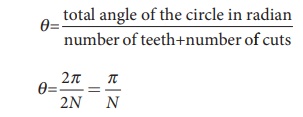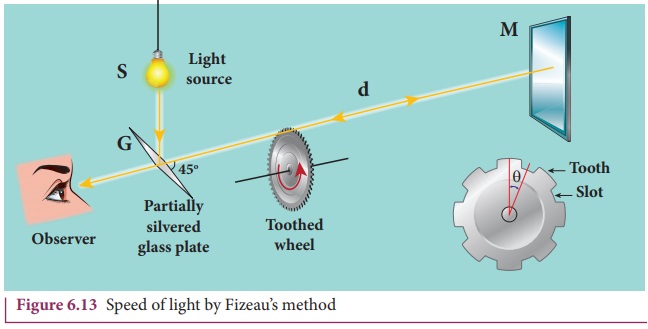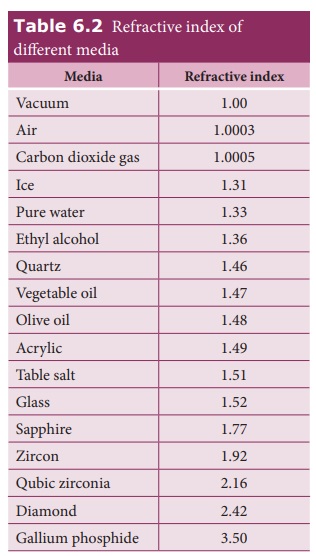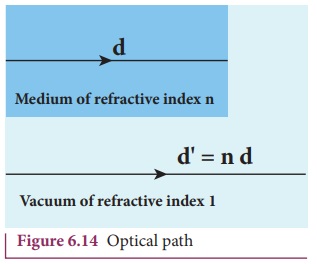Optics | Physics - Speed of Light | 12th Physics : UNIT 6 : Ray Optics
Chapter: 12th Physics : UNIT 6 : Ray Optics
Speed of Light
SPEED OF LIGHT
Light travels with the highest speed
in vacuum. The speed of light in vacuum is denoted as c and its value is, c = 3×108 ms-1. It
is a very high value. Several attempts were made by scientists to determine the
speed of light. The earliest attempt was made by a French scientist Hippolyte
Fizeau (1819– 1896). That paved way for the other scientists too to determine
the speed of light.
Fizeau’s method to determine speed of light
Apparatus: The apparatus used by Fizeau for determining speed of light in
air is shown in Figure 6.13. The light from the source S was first allowed to fall on a partially silvered glass plate G kept at an angle of 45º to the
incident light from the source. The light then was allowed to pass through a
rotating toothed-wheel with N teeth
and N cuts of equal widths whose speed
of rotation could be varied through an external mechanism (not shown in the Figure).
The light passing through one cut in the wheel will get reflected by a mirror M kept at a long distance d, about 8 km from the toothed wheel. If the toothed wheel was not rotating,
the reflected light from the mirror would again pass through the same cut and
reach the eyes of the observer through the partially silvered glass plate.
Working: The angular speed of rotation of the toothed wheel was
increased from zero to a value ω until
light passing through one cut would completely be blocked by the adjacent
tooth. This is ensured by the disappearance of light while looking through the
partially silvered glass plate.
Expression for speed of light: The speed of light in air v
is equal to the ratio of the distance
the light travelled from the toothed wheel to the mirror and back 2d to the time taken t.

The distance d is a known value from the arrangement. The time taken t for the light to travel the distance
to and fro is calculated from the angular speed ω of the toothed wheel.
The angular speed ω of the toothed wheel when the light
disappeared for the first time is,

Here, θ is the angle between the tooth and the slot which is rotated by
the toothed wheel within that time t.


Substituting for θ in the equation 6.13. for ω,

Rewriting the above equation for t,

Substituting t from equation (6.14)
in equation (6.12),

After rearranging,

Fizeau had some difficulty to
visually estimate the minimum intensity of the light when blocked by the
adjacent tooth, and his value for speed of light was very close to the actual
value. Later on, with the same idea of Fizeau and with much sophisticated instruments,
the speed of light in air was determined as, v = 2.99792×108 m s–1.
After the
disappearance of light for the first time while increasing the speed of
rotation of the toothed-wheel from zero to ω, on further increase of speed of
rotation of the wheel to 2ω, the
light would appear again due to the passing of reflected light through the next
slot. So, for every odd value of ω, light will disappear (stopped by tooth) and
for every even value of ω light will appear (allowed by slot).
Speed of light through different media
Different transparent media like
glass, water etc. were introduced in the path of light by scientists like
Foucault (1819– 1868) and Michelson (1852–1931) to find the speed of light in
different media. Even evacuated glass tubes were also introduced in the path of
light to find the speed of light in vacuum. It was found that light travels
with lesser speed in any medium than its speed in vacuum. The speed of light in
vacuum was determined as, c = 3×108
m s-1. We could notice that the speed of light in vacuum and in air
are almost the same.
Refractive index
Refractive index of a transparent medium is
defined as the ratio of speed of light in vacuum (or air) to the speed of light
in that medium.

Refractive index of a transparent
medium gives an idea about the speed of light in that medium.
EXAMPLE 6.5
One type of transparent glass has
refractive index 1.5. What is the speed of light through this glass?
Solution

Light travels with a speed of 2 × 108
ms-1 through this glass.
Refractive index does not have unit.
The smallest value of refractive index is for vacuum, which is 1. For any other
medium refractive index is greater than 1. Refractive index is also called as
optical density of the medium. Higher the refractive index of a medium, greater
is its optical density and speed of light through the medium is lesser and vice
versa. [Note: optical density should not be confused with mass density of the
material of the medium. They two are different entities]. The Table 6.2 shows
the refractive index of different transparent media.
Table 6.2 Refractive index of different media

Media : Refractive index
Vacuum: 1.00
Air: 1.0003
Carbon dioxide gas: 1.0005
Ice: 1.31
Pure water: 1.33
Ethyl alcohol: 1.36
Quartz: 1.46
Vegetable oil: 1.47
Olive oil: 1.48
Acrylic: 1.49
Table salt: 1.51
Glass: 1.52
Sapphire: 1.77
Zircon: 1.92
Qubic zirconia: 2.16
Diamond: 2.42
Gallium phosphide: 3.50
Optical path
Optical path of a medium is defined as the
distance d' light travels in vacuum
in the same time it travels a distance d in
the medium.
Let us consider a medium of
refractive index n and thickness d. Light travels with a speed v through the medium in a time t. Then we can write,
v = d/t ; rewrittenas, t = d/v
In the same time, light can cover a
greater distance d' in vacuum as it
travels with greater speed c in
vacuum as shown in Figure 6.14. Then we have,

c= d′/t ; rewritten as, t = d′/c
As the time taken in both the cases
is the same, we can equate the time t as,

rewritten for the optical path d' as, d′ = c/v d
As, c/v = n; The optical path
d' is,

As n is always greater than 1, the optical path d' of the medium is always greater than d.
EXAMPLE 6.6
Light travels from air in to glass
slab of thickness 50 cm and refractive index 1.5.
(i) What is the
speed of light in glass?
(ii) What is the time taken by the
light to travel through the glass slab?
(iii) What is the optical path of
the glass slab?
Solution
Given, thickness of glass slab, d = 50 cm = 0.5 m, refractive index, n = 1.5
refractive index, n = c/v
speed of light in glass is,

Time taken by light to travel
through glass slab is,

Optical path,
d′ = nd = 1.5×0.5 = 0.75 m =
75 cm
Light would have travelled 25 cm
more (75 cm – 50 cm) in vacuum by the same time had there not been a glass
slab.
Related Topics